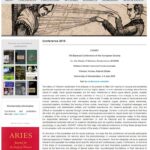This lecture presents the alternative spiritual cinema world, as part of a research project that focuses on the historical emergence of this mocement in the early years of the 21st century, while adapting current characteristics, and creating a unique art different than the mainstream media and cinema.
The lecture by Marianna Ruah-Midbar Shapiro and Lila Moore toop part in the conference of the European Society for the Study of Western Esotericism (ESSWE 7), held at Amsterdam University, The Netherlands, summer 2019. The conference’s focus was: “Western Esotericism and Consciousness: Visions, Voices, Altered States”. The lecture took place in a session dedicated to film and media.
One may dowload the presentation and abstract, but sadly no record/video is available.
There are further mutual researches of the scholars on the subject of Biblical Films. A lecture on another reseach in the field of spiritual cinema, of Marianna Ruah-Midbar Shapiro and another partner, was held in another university in Amsterdam. See links below.
Abstract
Since the release of films such as What the Bleep Do We Know and the launch of The Spiritual Cinema Circle (a monthly DVD subscription service that distributes spiritually-themed films) in 2004, numerous spiritually-motivated films and media products have become available. Both the Bleep and the Circle are milestones representing the beginning of what could be defined as a global cultural movement of spiritual cinema and media, a phenomenon unique to the 21st century that coincides with, and is sustained by, developments in digital technologies, the Internet and social media.
A major characteristic of the contemporary landscape of spiritual film and media is the considerable amount of independent productions that engage with aspects of alternative spiritualities. These films can be divided into typical genres, i.e., documentary, fiction, etc. However, a typological analysis demonstrates sub-categories dedicated to descriptions of unique spiritual practices such as: channeling, reincarnation, visionary altered-states, alchemy, self-hypnosis, and more. Typological study of films and media on such topics exemplifies the different viewpoints, aesthetics, and methods through which phenomena involving mind/body alternations are explored both by the filmmakers and the viewers/users.
Unlike mainstream cinema that often must appeal to traditional religious values and restricted by conservative ideologies, these independent and often low budget productions are niched towards their audiences that seek alternative modes of spirituality, e.g., contemporary Esotericism, which can be incorporated into Western lifestyle. Consequently, the spiritual teachings depicted mirror the social and cultural context of the contemporary spiritual movement.
Furthermore, each sub-category presents aspects of religious/spiritual consciousness from a visual/audial/artistic viewpoint. Thus, we shall demonstrate via a review of selected films, notably new perceptions and comprehensions that may arise in the viewers, whether they are laypersons or scholars. The motivation of enlightening the public and altering minds is actually the major purpose of the spiritual films.
Films mentioned in the lecture:
Conversations with God (2006)
She Sings to the Stars (2015)
The Alchemical Dream: The Rebirth of the Great Work (2008)
The Alma Drawings (2005)
The Secret (2006)
What the Bleep Do We Know (2004)
On the main subject of the conference, from ESSWE’s website:
The history of Western esotericism from antiquity to the present is filled with reports of unusual and sometimes spectacular experiences that are claimed to convey higher, deeper, or even absolute knowledge about the true nature of reality. Some typical examples are the many references to direct supra-rational gnosis, ecstatic experiences, and states of divine manía (madness or frenzy) or possession from antiquity to the present; visionary travels to other places, other worlds, or other levels of reality, as well as to past or future periods and events; visionary encounters with intermediary beings (for instance angels, demons, spirits, elementals, ascended masters, divinities); the hearing of inner voices, receiving or “channeling” of spiritual messages, and communication with disembodied entities; and ineffable experiences (for instance apophatic unity) that are difficult or impossible to express through normal discursive language. Common to all such reports is that they fall within the general phenomenology of human consciousness and seem to require some kind of modification or alteration of the normal or average mental states that allow us to negotiate consensus reality. All this makes the experiential dimension of Western esotericism (in both its historical and its contemporary social manifestations) extremely relevant to academic disciplines such as cognitive studies, consciousness research, psychology, or psychiatry. ESSWE7 will be the first major international conference to bring these perspectives in conversation with one another in the context of the study of Western esotericism.
On the level of the humanities and the social sciences, we hope that the conference will provide participants with an ideal opportunity for learning about the phenomenology of unusual experiences across the entire historical spectrum of Western esotericism from antiquity to the present. Here the emphasis will be on empirical research and specialist knowledge about specific historical and contemporary cases. Furthermore, on the level of the study of consciousness, we hope to explore larger and more theoretical questions concerning such topics as the taxonomy and etiology of altered states, their neurobiological foundations, or their relevance to wider concerns such as cognitive functioning or mental health. Here the emphasis will be on how such approaches may help us understand and even explain the rich record of historical and empirical materials central to Western esotericism and, conversely, how these can serve as case studies for the study of consciousness more in general.
ESSWE7 will also be an occasion to celebrate the 20th anniversary of the Center for History of Hermetic Philosophy and Related Currents (HHP) at the University of Amsterdam.
Lecturers
Marianna Ruah-Midbar Shapiro
Lila Moore
Links
To download the abstract file of the lecture – click here.
For the conference programme – click here.
For the booklet of all the abstracts of the conference lectures – click here.
For the ESSWE7 conference website – click here.
For the ESSWE7 conference page on the European Society for the Study of Western Esotericism website – click here.
For the facebook page of the Soceity – click here.
For the facebook page of the Spiritual Cinema Circle – click here.
Date
2nd-4th July, 2019
Language
English
Academic/Non-academic
Academic item
Bibliographical citation
Moore, Lila, and Marianna Ruah-Midbar Shapiro, “The Emergent Contemporary Movement of Spiritual Cinema and Media: “Explorations in Mind/Body Alternations”, a lecture at the 7th Biennial Conference of the European Society for the Study of Western Esotericism (ESSWE), University of Amsterdam, 2-4 July 2019.



















